
Start closing the strategy > delivery gap
5 ways to accelerate organisational transformation
Easy-to-use techniques from behavioural science to help you lead the change.
When you’re in the midst of a big transformational change, it can feel like you are pushing a rock up a never ending hill.
If you’re looking to rekindle your passion for change and catapult that rock ahead, this article is for you.
We introduce 5 tools from behaviourial science that can help you lead the transformation and rekindle that spark. You’ll learn techniques to:
-
Built your team with intention
-
Drive behaviour change
-
Navigate team motivation
-
Turn perceived failures into learning opportunities
Build a cognitively diverse team
Your team is core to your transformation. According to research by Procter & Gamble, there are four specific types of cognitive diversity found among the highest performing teams:
- Generators - people who love seeing opportunity, getting things started, or really bringing energy and lighting a fire underneath a challenge.
- Conceptualisers - people who are amazing at coming up with a range of different possible ways you could solve a problem.
- Optimisers - people who are phenomenal at taking those options and identifying the optimal path forward.
- Implementers - people who get their kicks from ticking things off the list and making things happen.
Intentionally structuring teams to balance these styles ensures each person feels a sense of belonging in the innovation process.
Invite your team to take the Basadur Profile to identify the cognitive diversity on your team. Explore the results together. If you find you are missing the perspective of thinkers in one of the quadrants, consider how rebalancing your team may help navigate some of the challenges your team faces.
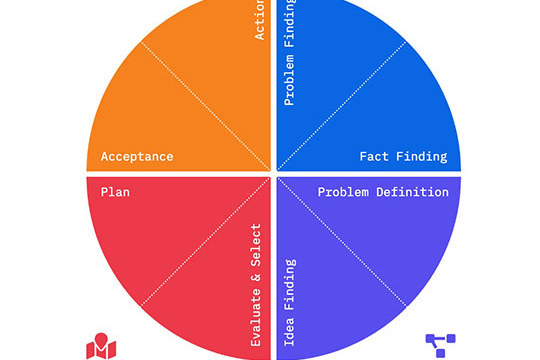
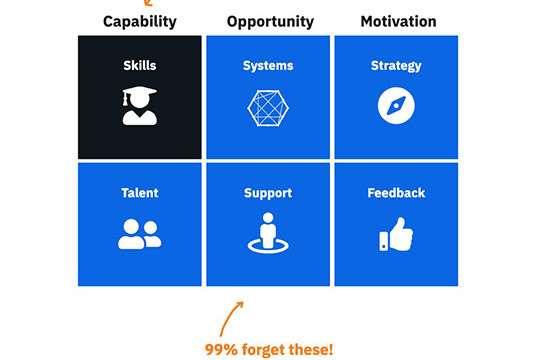
Identify capability, opportunity, and motivation for change
There’s most likely a specific behaviour that you're looking to drive. Change falters when people are not embodying the behaviours needed for the change to be successful.
If you’re struggling with teams adopting new behaviours, check if they have the Capability, Opportunity, and Motivation to make the change.
- Capability - Do you have the right skills and talents within the team for people to be able to know and be confident doing the new behaviour that you're asking them to do?
- Opportunity - Does the team have both the resources (budget, time, materials) and support from peers and leadership to meaningfully engage in the new behaviour?
- Motivation - Do people understand where they're headed and get reinforcement that they're on the right track? Do people know what's in it for them as a member of the team? Does the behaviour feel normal to actually take part in?
When we have those three things, we get the behaviour that we're looking for. Use the list above as a checklist to identify which level may be standing in the way for you.
Learn more about the COM-B formula for behavioural change here.
Reframe failure
You're not going to get everything right the first time. You need a team around you who are comfortable with the discomfort of trying new things. Without this, the change will never gain momentum and the organisation will revert back to doing what you've always done.
What holds teams back is often a fear of failure. They fear (consciously or unconsciously) they’ll lose social capital by not getting it right the first time–it’s called Loss Aversion.
Loss aversion is the idea that we will put more energy into avoiding losing something than we would have put into gaining something of the equivalent value.
Turn this fear into something that is usable by the team. Turning the idea of failure as a loss into failure as a gain in knowledge.
Have an honest conversation with the team. Share a story about a time you tried something that didn't go to plan, but you learned something invaluable. Make a plan for how the team will handle and learn from missteps before they happen.
For inspiration, Mercedes-Benz have an interesting way of encouraging teams to embrace the idea of failure as learning–they run FuckUp Nights. Learn more here.
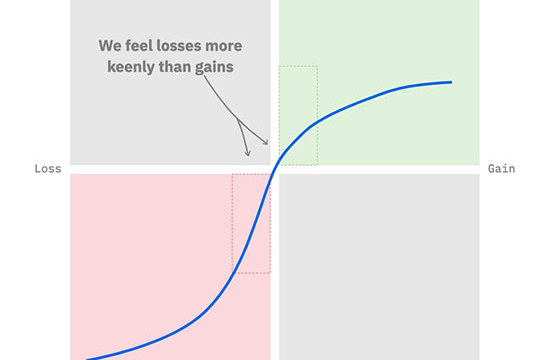
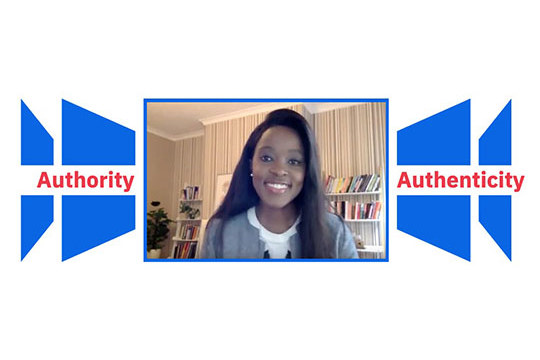
Find the right messenger
We’ve all been there. An opinion you share with your team is easily dismissed. Someone from another department says the same thing and it's suddenly a major revelation.
It’s called the messenger effect. The person who is conveying a message or making an ask has a disproportionate impact on whether or not somebody will do the thing that you're asking them to do.
Recognising this effect can be a powerful tool as a leader of change. Once you do, there are two types of messengers you can turn to:
- Authority (hard messenger) - someone with a perceived power, status or respect that people want to be associated with–think team captain, celebrity spokesperson or C-suite.
- Authenticity (soft messenger) - someone people easily relate with or feel connected to like a counterpart in another department or friends.
If your transformation isn’t landing, try changing the messenger.
Maintain momentum on the journey
There is a very common pattern people experience in the midst of change: From excitement to doubt, to progress and finally success.
As a change leader it’s important to recognise where your team is on the journey. You’ll find there are 4 key phases:
- The Honeymoon - Motivation is sky high. Everything is exciting, things are going to be great. The team don’t recognise it yet, but they’ve never taken on this specific challenge in this context. That’s going to get intimidating quick.
- Crash - Motivation plummets. They start wondering: Do I really want to do this? Am I the right person? Can I really achieve what we need to achieve?
- Climb - The team’s capability starts to build as they understand the nuances of that new challenge. As a result, motivation starts climbing as well.
- Plateau - The team’s capability is really growing, motivation is climbing as well.
Normalising this experience in your team pays dividends. It means that when the team is at their lowest, they’ll be able to see light at the end of the tunnel. And, as a leader, you have different leadership styles that you can use in different phases in this curve–see how to shift your leadership style here.
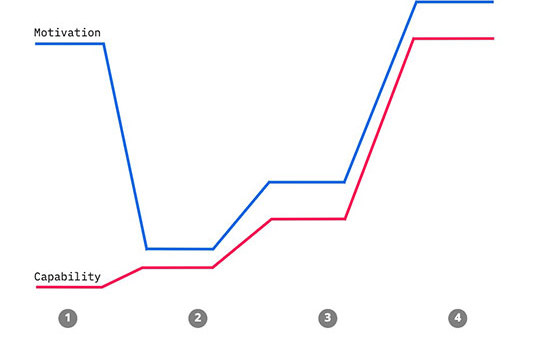
CHANGE BY SPRINT VALLEY
Discover our award-winning Change methodology.
When leading Behaviour Change and innovation experts become your sidekicks, magic happens.
